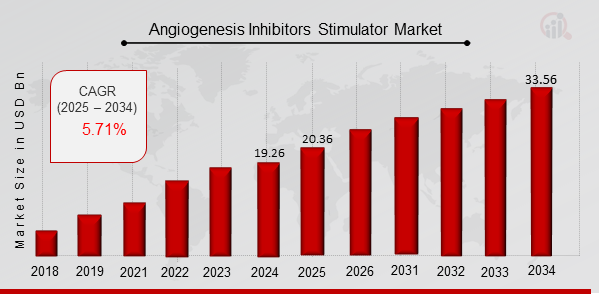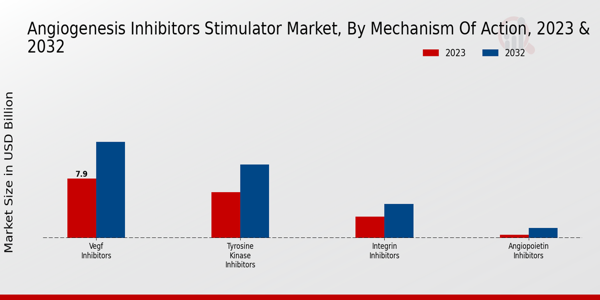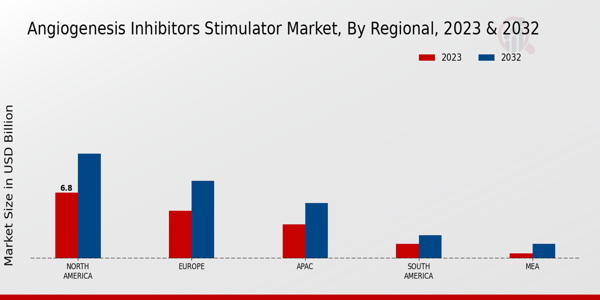Angiogenesis Inhibitors Stimulator Market Overview
As per MRFR analysis, the Angiogenesis Inhibitors Stimulator Market Size was estimated at 19.26 (USD Billion) in 2024. The Angiogenesis Inhibitors Stimulator Market Industry is expected to grow from 20.36 (USD Billion) in 2025 to 33.56 (USD Billion) till 2034, at a CAGR (growth rate) is expected to be around 5.71% during the forecast period (2025 - 2034).
Key Angiogenesis Inhibitors Stimulator Market Trends Highlighted
The angiogenesis inhibitors and stimulators market is experiencing significant growth driven by various factors. The rising prevalence of diseases such as cancer, where angiogenesis plays a critical role in tumor growth, is a key market driver. Advances in biotechnology and pharmaceutical research have led to the development of targeted therapies that effectively inhibit angiogenesis, providing new treatment options for patients. Furthermore, the increasing investment in healthcare infrastructure and research initiatives supports innovation and the introduction of new products into the market. As healthcare providers seek more effective therapies, the demand for angiogenesis inhibitors is expected to rise.
Opportunities within the market are abundant, particularly in the expanding field of personalized medicine. There is a growing trend toward the development of tailored therapies based on individual patient profiles, which could lead to more effective treatments with fewer side effects. Additionally, the use of combination therapies, where angiogenesis inhibitors are used alongside other treatment modalities, offers a promising avenue for enhancing treatment efficacy. Emerging markets also present opportunities for growth as healthcare systems evolve and access to advanced treatments improves. Recently, there has been a notable trend towards the exploration of natural compounds and their role in angiogenesis modulation.
Researchers are investigating various plant-derived substances that may serve as effective inhibitors or stimulators of angiogenesis. This shift reflects a broader interest in holistic and integrative approaches to healthcare. The trend of increasing collaboration among pharmaceutical companies, academic institutions, and research organizations is also paving the way for innovative solutions and expedited drug development processes. Overall, the dynamics within the angiogenesis inhibitors and stimulators market are poised for positive change, driven by ongoing research, technological advancements, and a focus on targeted therapies.

Angiogenesis Inhibitors Stimulator Market Drivers
Increase in Prevalence of Cancer and Other Diseases
The rise in the incidence of cancer and other diseases requiring angiogenesis inhibitors is a significant driver for the Angiogenesis Inhibitors Stimulator Market Industry. As the world population ages, the prevalence of age-related diseases such as cancer, cardiovascular disorders, and ocular diseases is on the rise. These conditions often require advanced therapeutic options to manage and improve patient outcomes. Angiogenesis inhibitors target the formation of new blood vessels that tumors and diseased tissues need for growth, thereby providing a crucial therapeutic avenue for both patients and healthcare providers.
Moreover, a focus on targeted therapy for cancer treatment demonstrates a shift in therapeutic approaches, emphasizing personalized medicine. This trend leads to increased research and development investments in the Angiogenesis Inhibitors Stimulator Market Industry. Pharmaceutical companies are also actively seeking to innovate their product lines to meet the growing demand for effective treatments that can enhance patients' quality of life and potentially improve survival rates.
The convergence of increased disease prevalence and advancements in drug discovery and development presents a robust opportunity for growth within the Angiogenesis Inhibitors Stimulator Market.
Technological Advancements in Drug Development
The Angiogenesis Inhibitors Stimulator Market Industry is significantly influenced by the rapid technological advancements in drug development. Innovations in biomedical research, coupled with advancements in molecular biology and genomics, have paved the way for the discovery of novel angiogenesis inhibitors. New technologies, such as high-throughput screening and computational drug design, enable researchers to identify and optimize compounds more effectively than ever before.
This increased efficiency in drug design and development not only accelerates the time it takes to bring new therapies to market but also improves the success rates of clinical trials. As a result, we can expect a growing pipeline of angiogenesis inhibitors that are tailored to specific patient needs, expanding treatment options and enhancing therapeutic outcomes.
Growing Investment in Healthcare Infrastructure
Investment in healthcare infrastructure is a pivotal driver contributing to the growth of the Angiogenesis Inhibitors Stimulator Market Industry. As governments and private sectors around the world allocate more resources to improve healthcare facilities, accessibility to advanced medical treatments is increasing. This expansion includes enhanced oncology departments that focus on innovative treatments, including angiogenesis inhibitors. Improved access to healthcare services enables more patients to receive timely and appropriate care, boosting demand for effective therapies.
Moreover, with the expansion of healthcare infrastructure, there is a surge in initiatives to promote awareness and research into angiogenesis-related diseases, paving the way for further developments in this market.
Angiogenesis Inhibitors Stimulator Market Segment Insights
Angiogenesis Inhibitors Stimulator Market Mechanism of Action Insights
The Angiogenesis Inhibitors Stimulator Market is experiencing significant development, particularly within the Mechanism of Action segment, which underpins various therapeutic approaches in addressing disease states linked to abnormal blood vessel formation, such as cancer and ocular disorders. In 2023, the total market valuation stood at 17.23 USD Billion, reflecting a strong interest in this sector. The primary mechanisms include VEGF Inhibitors, Tyrosine Kinase Inhibitors, Integrin Inhibitors, and Angiopoietin Inhibitors. Among these, VEGF Inhibitors command a majority holding, with a valuation of 7.9 USD Billion in 2023 and expected to rise to 12.8 USD Billion by 2032. This segment is crucial as it directly targets the vascular endothelial growth factors involved in the formation of new blood vessels, making it particularly significant in the treatment of various malignancies.
Tyrosine Kinase Inhibitors follow closely behind, boasting a market value of 6.1 USD Billion in 2023, projected to increase to 9.8 USD Billion in 2032. This mechanism targets specific receptors and pathways that promote angiogenesis and tumor growth, thereby playing an essential role in cancer therapies. Integrin Inhibitors, although less prominent with a valuation of 2.8 USD Billion in 2023, are integral in modulating cell adhesion and migration, impacting tumor progression significantly. They have a projected growth of 4.5 USD Billion by 2032, demonstrating increasing recognition of their potential in combination therapies. Angiopoietin Inhibitors represent the niche within this market, with a value of 0.43 USD Billion in 2023, set to rise to 1.32 USD Billion by 2032. This mechanism plays a specialized role in modifying the blood vessel stability and permeability, which is gaining traction in therapeutic development. The trends within these mechanisms show a robust and evolving landscape driven by the need for targeted therapies and the growing understanding of angiogenic pathways. The overall market growth is bolstered by increasing incidences of cancer and age-related diseases, offering lucrative opportunities for stakeholders in the Angiogenesis Inhibitors Stimulator Market as they look to innovate and expand their offerings to meet the demand for effective angiogenesis modulation therapies.

Source Primary Research, Secondary Research, MRFR Database and Analyst Review
Angiogenesis Inhibitors Stimulator Market Application Insights
The Angiogenesis Inhibitors Stimulator Market is expected to see significant growth, with a market value of 17.23 billion USD projected for 2023. This growth is influenced by various applications such as Cancer Treatment, Eye Disorders, Chronic Inflammatory Diseases, and Cardiovascular Diseases. Cancer Treatment remains a major focus within this market, driven by the increasing prevalence of different cancer types and the need for effective therapies. Eye Disorders, including conditions like age-related macular degeneration, also play a substantial role due to rising incidences that require advanced therapeutic solutions.
Chronic Inflammatory Diseases, which encompass a wide range of conditions, are increasingly being recognized for their impact on quality of life, further fueling market demand. Cardiovascular Diseases are another critical area, with angiogenesis inhibitors showing promise in treating conditions related to heart health. The Angiogenesis Inhibitors Stimulator Market segmentation reveals how these applications collectively enhance the understanding and effectiveness of treatments, addressing key health challenges faced globally. Market growth is supported by advancing medical technologies and an increasing emphasis on research and development aimed at improving patient outcomes.
Angiogenesis Inhibitors Stimulator Market Route of Administration Insights
The route of administration plays a crucial role in the effective delivery of these therapies, significantly impacting patient compliance and therapeutic outcomes. Oral administration is recognized for its convenience and ease of use, appealing to a broad patient base. Intravenous routes are essential for immediate therapeutic effects, often utilized in acute settings where rapid intervention is necessary. Subcutaneous administration has emerged as a significant option due to its relative ease and potential for self-administration, enhancing treatment adherence.
These varying routes align with different patient needs and therapeutic requirements, thus shaping the overall dynamics of the Angiogenesis Inhibitors Stimulator Market revenue. The market statistics indicate a complex interplay of preferences and practices driving the demand for these administration methods, with trends leaning towards innovative formulations that improve patient experience and efficacy. Factors such as an increasing prevalence of cancer and other disorders requiring angiogenesis inhibitors propel the market growth, while challenges related to administration techniques and patient access remain critical considerations.
Angiogenesis Inhibitors Stimulator Market End Use Insights
The Angiogenesis Inhibitors Stimulator Market, valued at 17.23 billion USD in 2023, showcases a diverse End Use segmentation that significantly impacts market dynamics. Hospitals play a crucial role in the application of angiogenesis inhibitors, offering cutting-edge treatments and clinical trials that cater to patients with various conditions related to abnormal blood vessel growth. Research Laboratories contribute by facilitating the discovery of novel therapies and understanding the underlying mechanisms of angiogenesis, which drives innovation in the market.
Pharmaceutical Companies dominate this landscape, focusing on the development and commercialization of targeted therapies, leveraging substantial investments in research and development to enhance treatment efficacy and patient outcomes. With the increasing prevalence of diseases such as cancer, the demand from these sectors is projected to rise, influencing the Angiogenesis Inhibitors Stimulator Market revenue positively. Overall, the integration of these sectors fosters advancements that play a pivotal role in addressing challenging health conditions, thereby contributing to the overall market growth and providing numerous opportunities for investors and stakeholders in this industry.
Angiogenesis Inhibitors Stimulator Market Regional Insights
The Angiogenesis Inhibitors Stimulator Market revenue is showing a strong regional performance, with North America leading at 6.8 USD Billion in 2023 and projected to reach 10.8 USD Billion by 2032, highlighting its majority holding in the market due to advanced healthcare infrastructure and significant investments in research and development. Europe follows with a valuation of 4.9 USD Billion in 2023, expected to grow to 8.0 USD Billion, reflecting its robust pharmaceutical industry and increasing healthcare expenditures. The APAC region, valued at 3.5 USD Billion in 2023 and anticipated to reach 5.7 USD Billion, indicates a growing demand driven by rising awareness and accessibility to innovative treatments.
South America, while the smallest market at 1.5 USD Billion in 2023, shows potential for growth with an increase to 2.4 USD Billion, primarily due to improving healthcare systems and economic development. Lastly, the MEA region, valued at 0.53 USD Billion in 2023, is projected to expand to 1.5 USD Billion, suggesting opportunities in emerging markets. As such, the Angiogenesis Inhibitors Stimulator Market segmentation by region suggests considerable growth potential and varied dynamics across different geographical areas, driven by health service modernization and increased investment in oncology treatments.

Source Primary Research, Secondary Research, MRFR Database and Analyst Review
Angiogenesis Inhibitors Stimulator Market Key Players and Competitive Insights
The Angiogenesis Inhibitors Stimulator Market is a dynamic and evolving sector characterized by significant competitive activity driven by advancements in biotechnology and pharmaceuticals. As research continues to uncover the mechanisms underlying angiogenesis, numerous companies are diving into this therapeutic area, enhancing their product portfolios and expanding their market presence. Key players in this market are focusing on innovative drug development, strategic collaborations, and extensive clinical trials to bring forth effective angiogenesis inhibitors that cater to diverse therapeutic needs, particularly in cancer treatment and other diseases linked to abnormal blood vessel growth. The landscape is also influenced by regulatory approvals and market access strategies, making competitive insights crucial for understanding the positioning and strategies of various companies within this critical domain.
Eli Lilly stands out in the Angiogenesis Inhibitors Stimulator Market owing to its robust research and development capabilities and an established reputation for innovation in pharmaceuticals. The company has strategically invested in the development of angiogenesis inhibitors, leveraging its extensive knowledge base and technological prowess to create effective treatments that address unmet medical needs. Eli Lilly's strong presence in the oncology segment positions it favorably, as angiogenesis plays a pivotal role in tumor growth and metastasis. Furthermore, the company has cultivated collaborative partnerships with research institutions and other biopharmaceutical companies to enhance its pipeline, solidifying its competitive advantage and ensuring a consistent flow of innovative solutions to the market.
Johnson and Johnson is a key player in the Angiogenesis Inhibitors Stimulator Market, recognized for its comprehensive approach to healthcare and its commitment to addressing complex medical conditions through targeted therapies. The company benefits from a diversified product portfolio and reach, allowing it to tap into various markets and meet the demands of different regions effectively. Johnson and Johnson's investment in cutting-edge research and commercial strategies has resulted in the development of advanced angiogenesis inhibitors, contributing to its reputation as a trusted provider of cancer care. The company's efforts to engage in strategic alliances with other firms further enhance its capabilities in drug development, thereby positioning it as a formidable competitor in the angiogenesis inhibitors market, particularly as the demand for innovative cancer treatments continues to rise.
Key Companies in the Angiogenesis Inhibitors Stimulator Market Include
Angiogenesis Inhibitors Stimulator Market Industry Developments
Recent developments in the Angiogenesis Inhibitors Stimulator Market have showcased significant advancements and competitive activities among leading pharmaceutical companies. Eli Lilly and Johnson & Johnson have been focusing on enhancing their oncology portfolios with innovative angiogenesis-targeting therapies. Roche continues to invest in research and development to strengthen its foothold, particularly in monoclonal antibodies for cancer treatment. AbbVie and Pfizer are also exploring partnerships to leverage complementary technologies in their oncology pipelines. The market has seen a notable increase in valuation, driven by the expanding application of angiogenesis inhibitors in treating chronic diseases, including various cancers. Merger and acquisition activities have intensified, with companies like Novartis and GSK potentially eyeing strategic alliances to enhance their capabilities in this domain. Notably, Regeneron Pharmaceuticals has been active in expanding its product offerings, and collaborations with academic institutions have been pivotal in propelling advancements. Overall, the current landscape reflects a robust and rapidly evolving market environment where established players such as Merck & Co, Amgen, and AstraZeneca are continuously seeking to innovate and capture growing opportunities in angiogenesis inhibition.
Angiogenesis Inhibitors Stimulator Market Segmentation Insights
Angiogenesis Inhibitors Stimulator Market Mechanism of Action Outlook
VEGF Inhibitors
Tyrosine Kinase Inhibitors
Integrin Inhibitors
Angiopoietin Inhibitors
Angiogenesis Inhibitors Stimulator Market Application Outlook
Cancer Treatment
Eye Disorders
Chronic Inflammatory Diseases
Cardiovascular Diseases
Angiogenesis Inhibitors Stimulator Market Route of Administration Outlook
Oral
Intravenous
Subcutaneous
Angiogenesis Inhibitors Stimulator Market End Use Outlook
Hospitals
Research Laboratories
Pharmaceutical Companies
Angiogenesis Inhibitors Stimulator Market Regional Outlook
North America
Europe
South America
Asia Pacific
Middle East and Africa
| Report Attribute/Metric |
Details |
|
Market Size 2024
|
19.26 (USD Billion)
|
|
Market Size 2025
|
20.36 (USD Billion)
|
|
Market Size 2034
|
33.56 (USD Billion)
|
|
Compound Annual Growth Rate (CAGR)
|
5.71 % (2025 - 2034)
|
|
Report Coverage
|
Revenue Forecast, Competitive Landscape, Growth Factors, and Trends
|
|
Base Year
|
2024
|
|
Market Forecast Period
|
2025 - 2034
|
|
Historical Data
|
2020 - 2024
|
| Market Forecast Units |
USD Billion |
| Key Companies Profiled |
Eli Lilly, Johnson and Johnson, Roche, HoffmannLa Roche, AbbVie, Pfizer, Novartis, GSK, Bayer, Regeneron Pharmaceuticals, BristolMyers Squibb, Merck and Co, Amgen, Sanofi, AstraZeneca |
| Segments Covered |
Mechanism of Action, Application, Route of Administration, End Use, Regional |
| Key Market Opportunities |
Increasing cancer prevalence, Rising demand for targeted therapies, Expansion in biopharmaceutical companies, Advancements in genetic therapies, and Growing awareness of angiogenesis role. |
| Key Market Dynamics |
Increasing cancer prevalence, Advancements in drug development, Growing research funding, Rising geriatric population, Expanding applications in chronic diseases |
| Countries Covered |
North America, Europe, APAC, South America, MEA |
Frequently Asked Questions (FAQ) :
The Angiogenesis Inhibitors Stimulator Market is expected to be valued at 33.56 USD Billion by 2034.
In 2023, the Angiogenesis Inhibitors Stimulator Market was valued at 17.23 USD Billion.
The Angiogenesis Inhibitors Stimulator Market is expected to grow at a CAGR of 5.71% from 2025 to 2034.
North America holds the largest market share, with a value of 6.8 USD Billion in 2023.
By 2032, the North American market size is expected to reach 10.8 USD Billion.
Key players include Eli Lilly, Johnson Johnson, Roche, and AbbVie among others.
In 2023, the market size of VEGF Inhibitors was valued at 7.9 USD Billion.
The Asia-Pacific region is projected to grow to 5.7 USD Billion by 2032.
The market size for Integrin Inhibitors is projected to reach 4.5 USD Billion by 2032.
The increasing prevalence of cancer and other diseases requiring angiogenesis inhibitors is driving market growth.


















